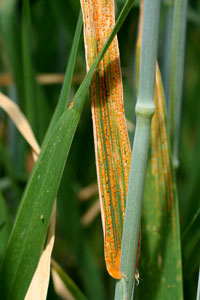Article and Image Courtesy : Down to Earth
Author : Jyotika Sood

Yellow rust is a fungal disease. The powdery yellow stripes on leaves hinder photosynthesis and make the grains shrivel. It is a serious disease, which has been threatening wheat cultivation in the country the past few years
Agriculture departments in northern Indian states have been put on high alert following the appearance of yellow rust disease in wheat crops in parts of Ropar district in Punjab and Una district in Himachal Pradesh.
Yellow rust is a fungal disease which manifests as powdery yellow stripes on leaves. These stripes hinder photosynthesis, make the grains shrivel and stunt growth of the plant. It is a serious disease, which has been threatening wheat cultivation in the country the past few years. All the wheat growing states like Punjab, Haryana, Himachal Pradesh, the tarai region of Uttarkhand, Uttar Pradesh and the low lying areas of Jammu and Kashmir are susceptible to the disease. According to estimates, farms spread over 300,000 hectares were hit by yellow rust in 2011.
This time the disease has appeared in Patti and Dher villages of Ropar in Punjab and Sunehra village in Una district of Himachal, says an agriculture department official at Ropar.
Warm winter, rains aid disease
Higher temperature combined with rains during wheat growing season aid the growth and spread of the disease, says Indu Sharma, head of the Directorate of Wheat Research, a body under the Indian Council for Agricultural Research (ICAR). Normally, December is marked by low temperature. But when the temperatures are high, between 3 to 4 degrees Celsius above normal, and accompanied by rain and fog, the environment becomes conducive for yellow rust. The impact of temperature and other factors is visible only in January. She adds that timely intervention had helped save around two million tonnes of wheat last year.